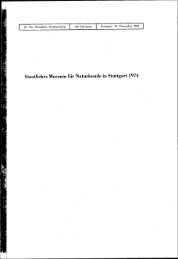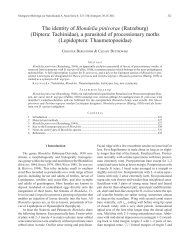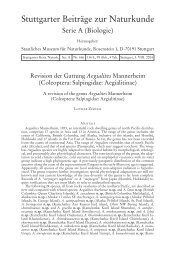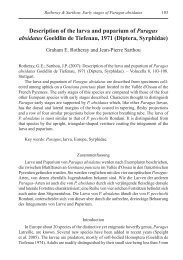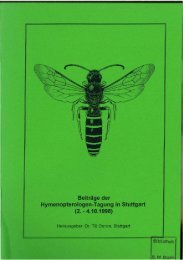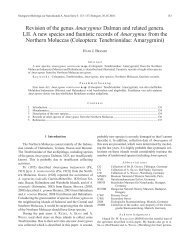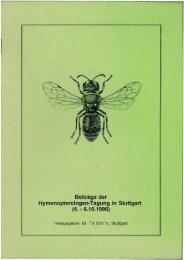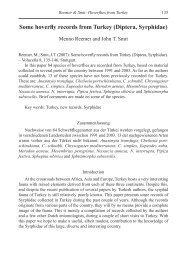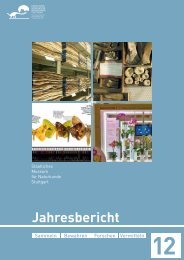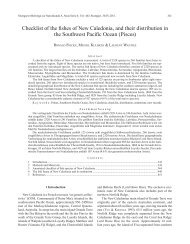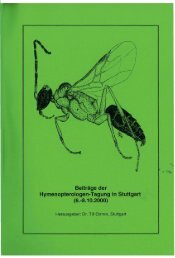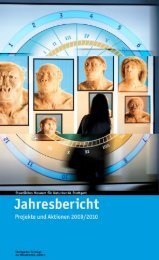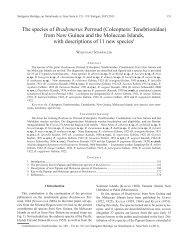Serie A (Biologie) - Staatliches Museum für Naturkunde Stuttgart
Serie A (Biologie) - Staatliches Museum für Naturkunde Stuttgart
Serie A (Biologie) - Staatliches Museum für Naturkunde Stuttgart
Create successful ePaper yourself
Turn your PDF publications into a flip-book with our unique Google optimized e-Paper software.
schawaller, oriental species of bradymerus 6128 Pronotal disc with a pair of prominent tubercles (Fig. 57). Aedeagus as in Fig. 122 . . . . . .. . . . . . . . . . . . . . . . . . . . . . . . . . . . . . . . . . . . . . . . . . . . . . . . . . . . . . . . . . . . . . . . B. nodicollis– Pronotal disc without a pair of prominent tubercles . . . . . . . . . . . . . . . . . . . . . . . . . . . . . 2929 Pronotal lateral margin without distinct crenulation (as in Fig. 19) . . . . . . . . . . . . . . . . . 30– Pronotal lateral margin with distinct crenulation (as in Fig. 18) . . . . . . . . . . . . . . . . . . . . 3130 Tibiae externally with feeble keels. Habitus as in Fig. 30. Parameres of aedeagus spade-like(Fig. 95). . . . . . . . . . . . . . . . . . . . . . . . . . . . . . . . . . . . . . . . . . . . . . . . . . . . . . . B. ferruginipes– Tibiae externally without keels. Habitus as in Fig. 40. Parameres of aedeagus more acute(Fig. 107) . . . . . . . . . . . . . . . . . . . . . . . . . . . . . . . . . . . . . . . . . . . . . . . . . . . . . . B. interstitialis31 Pronotal disc without granules between punctures (Fig. 56). Aedeagus as in Fig. 116 . . . .. . . . . . . . . . . . . . . . . . . . . . . . . . . . . . . . . . . . . . . . . . . . . . . . . . . . . . . . . . . . B. mindanaensis– Pronotal disc with granules between punctures . . . . . . . . . . . . . . . . . . . . . . . . . . . . . . . . . 3232 Frons without supraorbital keels . . . . . . . . . . . . . . . . . . . . . . . . . . . . . . . . . . . . . . . . . . . . . 33– Frons with distinct supraorbital keels . . . . . . . . . . . . . . . . . . . . . . . . . . . . . . . . . . . . . . . . . 3433 Body length 5.3–6.0 mm (Fig. 21). Parameres of aedeagus with rounder tip (Fig. 90) . . . . .. . . . . . . . . . . . . . . . . . . . . . . . . . . . . . . . . . . . . . . . . . . . . . . . . . . . . . . . . . . . . . . . . B. difficilis– Body length 7.5–8.0 mm (Fig. 20). Parameres of aedeagus more acute (Fig. 86) . . . . . . . . .. . . . . . . . . . . . . . . . . . . . . . . . . . . . . . . . . . . . . . . . . . . . . . . . . . . . . . . . . . . . . . . . B. celebensis34 Elytra long and parallel; elytral intervals without setation (Fig. 71). Joint parameres ofaedeagus pentagonal (Fig. 136) . . . . . . . . . . . . . . . . . . . . . . . . . . . . . . . B. thailandicus n. sp.– Elytra shorter; elytral intervals with setation. Joint parameres of aedeagus triangular . . . 3535 Elytral intervals with broader scale-like setae (Fig. 66). Joint parameres of aedeagus triangularwith rounder tip (Fig. 132) . . . . . . . . . . . . . . . . . . . . . . . . . . . . . . . . . . . . . B. serricollis– Elytral intervals with thinner scale-like setae (Fig. 18). Joint parameres of the aedeaguswith sinuated and acute tip (Fig. 91) . . . . . . . . . . . . . . . . . . . . . . . . . . . . . . . B. crenulicollis36 Tibia externally without distinct keels. Habitus as in Fig. 39. Aedeagus as in Fig. 108 . . . .. . . . . . . . . . . . . . . . . . . . . . . . . . . . . . . . . . . . . . . . . . . . . . . . . . . . . . . . . . . . . . . . B. kabakovi– Tibia externally with distinct keels . . . . . . . . . . . . . . . . . . . . . . . . . . . . . . . . . . . . . . . . . . . 3737 Frons with distinct supraorbital keels . . . . . . . . . . . . . . . . . . . . . . . . . . . . . . . . . . . . . . . . . 38– Frons without supraorbital keels . . . . . . . . . . . . . . . . . . . . . . . . . . . . . . . . . . . . . . . . . . . . . 3938 All elytral intervals with longitudinal and confluent tubercles forming interrupted keels,alternate intervals 3, 5, 7 slightly more prominent (Fig. 32). Aedeagus as in Fig. 98 . . . . . .. . . . . . . . . . . . . . . . . . . . . . . . . . . . . . . . . . . . . . . . . . . . . . . . . . . . . . . . . . . . . B. gebieni n. sp.– Internal elytral intervals smooth with small granules, external intervals with prominentlongitudinal granules (Fig. 9). Aedeagus as in Fig. 79 . . . . . . . . . . . . . . . . . . . . . . . B. aratus39 Body length 3.5 mm; pronotal disc between punctures with distinct tubercles; elytral interval3 in the middle with prominent keel (Fig. 69). Aedeagus as in Fig. 134 . . . . . . . . . . .. . . . . . . . . . . . . . . . . . . . . . . . . . . . . . . . . . . . . . . . . . . . . . . . . . . . . . . . . . B. sprecherae n. sp.– Body length 4.5–7.0 mm; pronotal disc between punctures with granules; elytral structuredifferent . . . . . . . . . . . . . . . . . . . . . . . . . . . . . . . . . . . . . . . . . . . . . . . . . . . . . . . . . . . . . . . . . 4040 Internal elytral intervals with separated granules, external intervals with longitudinal,partly confluent granules (Fig. 34). Joint parameres of aedeagus broader (Fig. 100) . . . . . .. . . . . . . . . . . . . . . . . . . . . . . . . . . . . . . . . . . . . . . . . . . . . . . . . . . . . . . . . . . . B. granulipennis– Elytral intervals with distinct longitudinal granules, on intervals 3, 5 partly confluent andforming keels (Fig. 11). Joint parameres of aedeagus narrower (Fig. 80) . . . . . . . . B. asper41 All eytral intervals slightly convex, neither with keels nor granules . . . . . . . . . . . . . . . . 42– At least some elytral intervals with distinct keels or rows of granules . . . . . . . . . . . . . . 4742 Anterior corners of pronotum protruding (as in Fig 12) . . . . . . . . . . . . . . . . . . . . . . . . . 43– Anterior corners of pronotum not protruding . . . . . . . . . . . . . . . . . . . . . . . . . . . . . . . . . 4443 Body length 10.8 mm; pronotum widest in the distal third (Fig. 12). Aedeagus as in Fig. 82. . . . . . . . . . . . . . . . . . . . . . . . . . . . . . . . . . . . . . . . . . . . . . . . . . . . . . . . . . . . . B. aulacopterus– Body length 6.5–7.5 mm; pronotum widest at the base (Fig. 38). Aedeagus as in Fig. 105 .. . . . . . . . . . . . . . . . . . . . . . . . . . . . . . . . . . . . . . . . . . . . . . . . . . . . . . . . . . . . . . . . B. incostatus44 Last 4 antennomeres forming a club . . . . . . . . . . . . . . . . . . . . . . . . . . . . . . . . . . . . . . . . . . 45– Last 5 antennomeres forming a club . . . . . . . . . . . . . . . . . . . . . . . . . . . . . . . . . . . . . . . . . . 4645 Habitus as in Fig. 7. Joint parameres of aedeagus broad with blunt tip (Fig. 77) . . . . . . . . .. . . . . . . . . . . . . . . . . . . . . . . . . . . . . . . . . . . . . . . . . . . . . . . . . . . . . . . . . . . . . . B. andamanus– Habitus as in Fig. 62. Joint parameres of aedeagus long with rounded tip (Fig. 126) . . . . .. . . . . . . . . . . . . . . . . . . . . . . . . . . . . . . . . . . . . . . . . . . . . . . . . . . . . B. pseudomalayicus n. sp.



